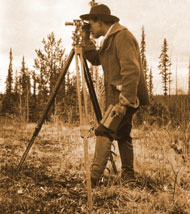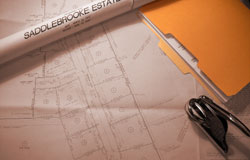 |
| .Describing the Job of the Land Surveyor |
 Surveying
has a long and storied history. The most famous character in America may
be George Washington, but surveying dates back at least to the ancient
Egyptians as evidenced by the remarkable accuracy and orientation of the
Great Pyramids. In fact, nearly every engineering marvel was built with
some form of a survey. Surveying was mentioned in the Bible, Joshua 18.
The Romans built roads and aquaducts, and George Washington's
experience as a surveyor gave him map-reading skills that helped him
to defeat the British.
Surveying
has a long and storied history. The most famous character in America may
be George Washington, but surveying dates back at least to the ancient
Egyptians as evidenced by the remarkable accuracy and orientation of the
Great Pyramids. In fact, nearly every engineering marvel was built with
some form of a survey. Surveying was mentioned in the Bible, Joshua 18.
The Romans built roads and aquaducts, and George Washington's
experience as a surveyor gave him map-reading skills that helped him
to defeat the British.Today's surveyors still face a wide variety of tasks. There isn't one survey job that stands out as the most important, but boundary surveys must be done by a surveyor who is licensed. Ownership of land should always be transferred according to boundaries established by surveyors. Such work is complex and essential. From a small residential plot plan, up to a commercial ALTA survey, the professional must balance the needs of the client with the agencies and standards of the industry.
 Another
aspect of surveying pertains to the Engineering world. The surveyor
provides the link between the engineer and the outside, natural world.
The engineer cannot begin to prepare his design without true and accurate
survey data. Traditionally this information is in the form of a map
prepared by the surveyor. Today's technology allows for faster transfer
of this information via a host of electronic devices and software. So
the surveyor must
stay current with technological advances.
Another
aspect of surveying pertains to the Engineering world. The surveyor
provides the link between the engineer and the outside, natural world.
The engineer cannot begin to prepare his design without true and accurate
survey data. Traditionally this information is in the form of a map
prepared by the surveyor. Today's technology allows for faster transfer
of this information via a host of electronic devices and software. So
the surveyor must
stay current with technological advances.In the same mediatorial manner, the surveyor also takes the design of the engineer and provides the contractor enough information to build the project. This "layout" or "stake out" carries with it enormous legal implications. Often the design isn't in the exact form requested or required by the contractor. The surveyor must stay in contact not only with the designer but also with the contractor in order to interpret the design and provide the calculations that allow the project to be completed. These calculations are often performed "on the fly" with the pressure of the contractors and equipment waiting to perform the work. Thus, a surveyor must be fast and accurate!
All of the advances in technology have made surveying a very challenging, exciting, and rewarding career. The diversity in the work requirements keep a surveyor on his toes. They must be knowledgeable, flexible, and often creative in their balancing of client and industry standards. And, of course, as if all the above weren't enough, surveyors must also deal with the elements every day!
